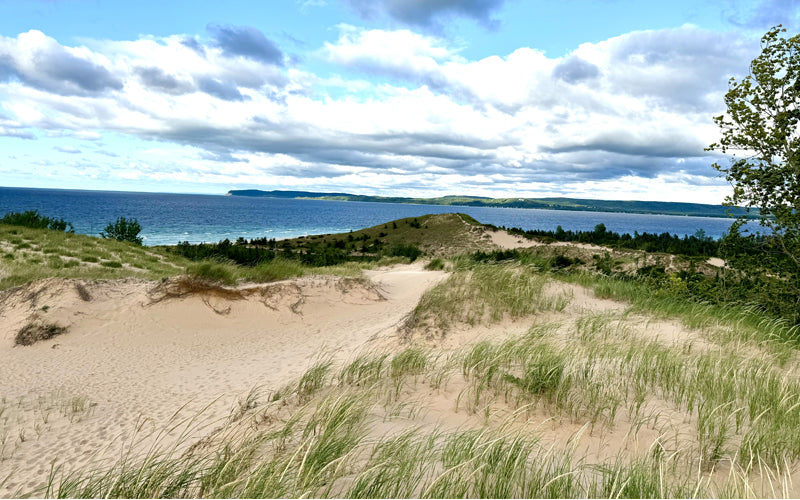
Explore Sleeping Bear Dunes - Michigan's National Treasure
Explore Sleeping Bear Dunes - Michigan's National Treasure
By Enjoy Michigan
Nestled along the northwest coast of Michigan's Lower Peninsula lies one of the USA's most breathtaking natural landscapes—Sleeping Bear Dunes National Lakeshore. A stunning expanse of towering sand dunes, lush forests, and pristine lakeshores that attracts visitors from all over the world. Sleeping Bear Dunes offers a unique blend of history, natural beauty, and recreational opportunities. In this blog post, we'll delve into the rich history of Sleeping Bear Dunes, explore its designation as a national park, and highlight the myriad of activities that make it Michigan's National Treasure and a must-visit destination.

Early 1900's Great Lakes fishing boat near Glen Haven
The History of Sleeping Bear Dunes
The history of Sleeping Bear Dunes is a tapestry woven with Native American legends, early settler stories, and conservation efforts. According to Native American folklore, the name "Sleeping Bear" comes from a legend of a mother bear and her two cubs. The story goes that the bears fled a forest fire in Wisconsin by swimming across Lake Michigan. The mother bear reached the shore and waited for her cubs, but they never arrived. The Great Spirit Manitou created the Sleeping Bear Dunes to commemorate the mother bear, and the Manitou Islands to represent her lost cubs.
The area was originally inhabited by the Anishinaabe people, who were part of the Odawa (Ottawa) tribe. They lived off the land, fishing in the lakes and rivers, hunting in the forests, and harvesting crops. European settlers arrived in the mid-19th century, bringing significant changes to the region. Lumbering became a major industry, with vast forests of pine and hardwoods being harvested and shipped out via the Manitou Passage.
As the lumber industry declined in the early 20th century, the area began to attract tourists. The natural beauty of the dunes, combined with the clear waters of Lake Michigan, made it a popular destination for summer visitors. Efforts to preserve the unique landscape began to gain traction, leading to the establishment of Sleeping Bear Dunes National Lakeshore in 1970.
National Park Designation
The journey to national park status was not without its challenges. Local residents and business owners were concerned about the potential impact on their livelihoods, while conservationists emphasized the importance of protecting the area's unique ecosystems and scenic beauty. After years of debate and negotiation, President Richard Nixon signed the bill establishing Sleeping Bear Dunes National Lakeshore on October 21, 1970.
The designation marked a significant step in the conservation of the Great Lakes region. The National Lakeshore covers over 71,000 acres, including 35 miles of Lake Michigan shoreline, two islands (North Manitou and South Manitou), and numerous inland lakes and streams. The park's mission is to preserve the natural and cultural resources of the area while providing opportunities for public enjoyment and education.

Sleeping Bear Dunes overlooking Lake Michigan
The Natural Beauty of Sleeping Bear Dunes
One of the most striking features of Sleeping Bear Dunes is its towering sand dunes. The dunes were formed over thousands of years by the action of wind, waves, and ice. The tallest dune, known as the Sleeping Bear Dune, rises approximately 450 feet above Lake Michigan, offering breathtaking views of the surrounding landscape.
The park's diverse ecosystems support a wide variety of plant and animal species. Visitors can explore dense forests of maple, beech, and oak, as well as open meadows and wetlands. In the spring and summer, wildflowers such as trillium, wild columbine, and lupine add bursts of color to the landscape. Birdwatchers will delight in the opportunity to see species like the Piping Plover, a threatened shorebird that nests on the park's beaches, as well as bald eagles, ospreys, and numerous songbirds.
The waters of Lake Michigan and the park's inland lakes are renowned for their clarity and purity. The azure waters provide a stunning contrast to the golden sands of the dunes, creating countless picturesque scenes that have inspired generations of photographers and artists.
Fun Things to Do at Sleeping Bear Dunes
Whether you're an outdoor enthusiast, a history buff, or simply looking for a relaxing getaway, Sleeping Bear Dunes has something to offer. Here are some of the top activities and attractions to enjoy during your visit:
1. Hiking
Sleeping Bear Dunes boasts an extensive network of hiking trails that cater to all skill levels. One of the most popular hikes is the Dune Climb, a challenging ascent up the face of the Sleeping Bear Dune. The effort is rewarded with panoramic views of Lake Michigan and the surrounding landscape. For a more leisurely hike, the Empire Bluff Trail offers a 1.5-mile round-trip walk through forests and meadows, culminating in a stunning overlook of the lake.
2. Scenic Drives
The Pierce Stocking Scenic Drive is a must-do for visitors who prefer to explore the park by car. This 7.4-mile loop road winds through dense forests and open meadows, offering numerous scenic overlooks and interpretive signs that provide insight into the area's natural and cultural history. Highlights include the Dune Overlook, where you can see the massive dunes rising above Lake Michigan, and the Lake Michigan Overlook, which provides a sweeping view of the shoreline.

Swimming at sunset at Good Harbor Beach
3. Beach Activities
The pristine beaches of Sleeping Bear Dunes are perfect for swimming, sunbathing, and picnicking. Popular spots include Platte River Point, where the Platte River meets Lake Michigan, and Good Harbor Bay, known for its clear, shallow waters. Kayaking and paddle boarding are also popular activities, with rentals available from local outfitters.
4. Camping
For those who want to immerse themselves in the natural beauty of the park, camping is a great option. The park offers both frontcountry and backcountry camping. The Platte River and D.H. Day campgrounds provide modern amenities such as restrooms, showers, and picnic areas. For a more rustic experience, backcountry camping is available on North Manitou Island, where visitors can hike, fish, and enjoy the solitude of the wilderness.
5. Exploring the Manitou Islands
A visit to Sleeping Bear Dunes isn't complete without a trip to the Manitou Islands. Accessible by ferry from Leland, these islands offer a glimpse into the area's maritime history and provide opportunities for hiking, camping, and exploring. South Manitou Island is home to the historic South Manitou Island Lighthouse, which dates back to 1871. Visitors can climb the tower for a panoramic view of the island and Lake Michigan. North Manitou Island, larger and more remote, offers backcountry camping and hiking, with miles of trails to explore.

The historic Glen Haven Canning Co. building in Glen Haven Village
6. Historical Sites
Sleeping Bear Dunes National Lakeshore is rich in cultural history, with several historical sites to explore. The Port Oneida Rural Historic District is a 3,400-acre area that preserves the rural landscape and buildings of 19th and early 20th-century farming communities. Visitors can tour historic farmsteads, barns, and houses, and learn about the agricultural practices and daily life of early settlers.
Another notable site is the Glen Haven Village, a restored 19th-century logging and shipping village. The village features several preserved buildings, including a blacksmith shop, general store, and the Cannery Boathouse Museum, which showcases a collection of historic boats and maritime artifacts.
7. Educational Programs
The National Lakeshore offers a variety of educational programs and ranger-led activities that provide deeper insights into the park's natural and cultural history. Programs include guided hikes, campfire talks, and workshops on topics such as geology, wildlife, and Native American culture. The Philip A. Hart Visitor Center in Empire serves as a hub for information, with exhibits, a bookstore, and knowledgeable staff to assist visitors.
8. Winter Activities
While Sleeping Bear Dunes is a popular summer destination, it also offers a range of winter activities. The park's trails are open for cross-country skiing and snowshoeing, providing a peaceful way to explore the snow-covered landscape. The Dune Climb becomes a popular spot for sledding, with families and children enjoying the thrill of racing down the slopes. Ice fishing is also a popular activity on the park's inland lakes, with anglers seeking perch, bluegill, and northern pike.

Sleeping Bear Dunes view of Lake Michigan near Glen Haven Village
Conclusion
Sleeping Bear Dunes National Lakeshore is a true gem of the Great Lakes region, offering a blend of natural beauty, outdoor adventure, and rich history. Whether you're hiking to the top of a towering dune, paddling on crystal-clear waters, or exploring a historic village, there's something for everyone to enjoy. The park's diverse landscapes and ecosystems provide endless opportunities for exploration and discovery, making it a must-visit destination for nature lovers and outdoor enthusiasts alike.
As you plan your visit to Sleeping Bear Dunes, remember to respect the natural environment and practice Leave No Trace principles. By doing so, you can help ensure that this beautiful and unique landscape remains preserved for future generations to enjoy. Whether you're visiting for a day, a weekend, or an extended stay, Sleeping Bear Dunes is sure to leave you with lasting memories and a deep appreciation for the natural wonders of the Great Lakes.
--When you are in the area, be sure to visit one of our Enjoy Michigan shops! Our Enjoy Michigan Traverse City store is located at 118 S. Union, Traverse City and our Enjoy Michigan Northport store is located at 104 W. Nagonaba, Northport. You'll find your favorite Michigan t-shirts, sweatshirts, hats and hoodies, plus some great gifts!

